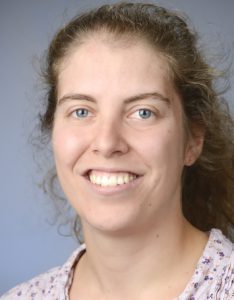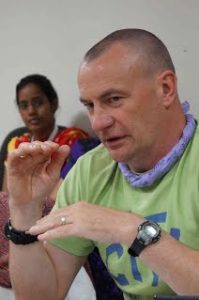
Sharif Aly
Sharif Aly is a veterinarian and epidemiologist who studies health, disease, and welfare primarily using herd health and epidemiological analytical tools. He is interested in vector-borne disease of cattle and is active in training residents and graduate students in the field.

Geoff Attardo
Geoff Attardo's research group focuses on the reproductive biology and physiology of insect vectors of human disease. They use a variety of tools ranging from classical behavioral and physiological analyses to 3d visualization, molecular biology, biochemistry and genetics. The primary subjects of their work have been mosquitoes and tsetse flies. Currently, the lab is focused on the biology behind the post-mating response in female tsetse flies which are unique insects that lactate and give birth to live young! The goal of this work is to identify and exploit biology that could be used to control tsetse fly populations. In addition, they are studying the physiology underlying insecticide resistance in the invasive mosquito Aedes aegypti which is rapidly spreading through California. This work involves behavioral, biochemical and genetic analyses of these mosquitoes to identify the mechanisms behind how these mosquitoes had adapted to overcome pressures from insecticides. They would like to utilize this information to detect the presence of resistance as well as to develop alternative approaches to help control the spread of these mosquitoes throughout California.

Chris Barker
Chris Barker's research group studies the factors that cause outbreaks of mosquito-borne viruses. They work closely with partners in public health and mosquito control on research to inform policy for disease prevention. Currently, they are studying the spread of invasive mosquitoes and chikungunya virus and the impacts of extreme drought on West Nile virus risk in California.

Nicole Baumgarth (Emeritus)
The Baumgarth lab is investigating immunity to Lyme disease, a tick-transmitted infection caused by the spirochete Borrelia burgdorferi that affects humans but also animals such as dogs and horses. Their studies have shown that B. burgdorferi actively suppresses long-term immune responses usually induced to an infection, explaining the relatively high rate of reinfections observed in endemic areas. Their current research is focused on identifying host-targets of the immune suppression in order to develop therapies that can strengthen immunity to this pathogen.

James R. Carey
James R. Carey and his associates focus on the biology and demography of aging and longevity in wild insect populations, with recent emphasis on the development of methods to estimate population age structure. Originally developed on their NIA-funded program concerned with the demography of wild fruit flies and referred to as the 'captive cohort method', the underlying concept is that the age structure of a vector (mosquito) population and the remaining longevity of its members are inextricably linked. Therefore patterns of post-capture longevity in wild-caught insect vectors can be used to gain insights into their population age structure, a demographic trait of great epidemiological importance.

Joanna Chiu
The main focus of our research is to understand the mechanisms underlying the regulation of animal circadian clock and its control over organismal physiology and behavior. Leveraging the molecular and genomic tools we have developed in studying circadian gene regulation in Drosophila, we have recently developed collaborative projects with Dr. Shirley Luckhart to examine epigenetic regulation of vector competence in the Malaria mosquito Anopheles gambiae and other closely-related species.

Gitta Coaker
The Coaker laboratory is investigating plant innate immunity against bacterial pathogens in model and crop plants. With respect to vector borne diseases, we are currently investigating the huanglongbing (HLB) associated bacterium Candidatus Liberibacter asiaticus which is transmitted the Asian citrus psyllid insect vector. HLB is a devastating citrus disease that is well established in Florida and Texas. We are examining the role of secreted plant proteases and secreted bacterial proteins for disease development.

Lark Coffey
Lark Coffey's team focuses on the ecology and evolution of arthropod-borne viruses including West Nile and chikungunya that are a significant cause of human disease, with no vaccines or treatment beyond palliative care. Their goal is to understand patterns of viral molecular evolution in enzootic and epidemic settings and the viral genetic factors that promote emergence of epidemic variants via host range changes. Studies also focus on how intrahost arboviral genetic diversity generated by error-prone viral replication to produce minority variants influences infectivity and transmissibility in mosquito and vertebrate hosts. The team is also developing approaches to improve arbovirus surveillance.

Patricia Conrad (Emeritus)
Pat Conrad's laboratory takes a One Health research approach to global human, animal and environmental health problems including tick-borne protozoal parasites, most notably Babesia in humans, wildlife, pets and livestock. She is committed to research mentorship of undergraduate, professional and graduate students, and the development of innovative educational approaches to promote inter-professional learning and engagement, particularly relating to global health.

Anthony Cornel
The Cornel lab is focused on population genetics and insecticide resistance of major vectors of human malaria in Africa and Brazil in collaboration with Gregory Lanzaro and Yoosook Lee. Other efforts are underway to study inter-epizootic zoonotic diseases of wildlife in South Africa, with a particular focus on competence, behavior, and systematics of arbovirus vectors. In addition, work on avian malaria hosts and vectors has revealed co-infecting parasite species and lineages that are likely to affect the diversity of parasite communities in time and space.

Bryce Falk (Emeritus)
The Falk lab has three main research areas in plant-vector borne diseases. The first area in molecular cell biology and genetics of plant viruses includes efforts ranging from diagnostics to natural diversity to novel strategies for genetic control. The second area combines multidisciplinary, collaborative efforts to express desirable nucleic acids/proteins in plants and plant cells for reverse genetic analysis of specific plant types. The third area is focused on the long term goal of identifying and using RNA interference to control insect vectors of plant pathogens.

Janet Foley
Students and affiliates in Janet Foley's laboratory are working on a diversity of projects relating to the ecology of vector-borne diseases with emphases on acarids (mites and ticks). Recently, they have worked collaboratively with agency and non-profit organization biologists to address devastating mange epidemics in eagles, kit foxes, bobcats and squirrels. Although each of the mite species that cause mange in these various hosts is different, they are concerned about climate or other broad scale ecological changes that may contribute to these mange epidemics.

Robert Gilbertson
Research in Dr. Gilbertson's lab is focused on insect-transmitted viruses of plants, including the thrips-transmitted Tomato spotted wilt virus and the leafhopper-transmitted Beet curly top virus. Along with several related international projects, the goals of this research are to develop a better understanding of aspects of the biology of insect vector-virus interactions and to help farmers better manage these diseases. Dr. Gilbertson teaches or co-teaches PLP 123 (Plant Virus Vector Interactions), PLP 120 (Introduction to Plant Pathology), and PLP 228 (Plant Bacteriology) and contributes lectures to PLP 230 (Plant Virology), MIC 262 (Advanced Virology), and PLS 105 (Integrated Pest Management).

Cecilia Giulivi
Research in the Giulivi laboratory is focused on mitochondria, bioenergetics and free radical biochemistry in several neurological and neurodegenerative disorders such as autism, fragile X tremor and ataxia syndrome (FXTAS), and Huntington's disease. These mechanisms are explored using a variety of biological models (isolated mitochondria, primary cell culture, established cell cultures, animal models including conditional knock-in and transgenic, human patient samples). The same approaches are being used for vector-borne diseases with studies on mitochondrial regulation of infection and transmission of malaria parasites and also of the protozoan pathogens of Chagas' disease.

Emir Hodzic
Emir Hodzic directs the Real-time PCR Research and Diagnostics Core Facility offering diagnostic and research services to the veterinary and academic communities including diagnostics of infectious agents (such as vector-borne diseases), and research for gene expression. With over 15 years of experience, the Real-time PCR Core Facility remains a leading competitor in the field of molecular detection.

Lynn Kimsey
Dr. Kimsey teaches introductory entomology, the prerequisite for medical entomology, the biology of parasitism and other insect related courses. In addition, Dr. Kimsey is the Director of the Bohart Museum of Entomology, which houses the fourth largest mosquito collection in the world, along with large collections of other pathogen vectors, such as tick, sandflies and mites. These collections are particularly important as repositories of research vouchers to make it possible to confirm species studied and replicate research. In addition, Dr. Kimsey and Dr. Robert Washino are revising and updating the monograph, 'Mosquitoes of California', an invaluable resource for both researchers and professionals.

Sharon Lawler
Vector ecology research in the Lawler lab focuses on the efficacy and non-target effects of mosquito control methods, including conventional pesticides, biologically-derived pesticides, predators, and suppression of aquatic weeds that harbor mosquito larvae. Sharon is currently the chair of the DEBVBD.

John Madigan
John Madigan has been working with tick-borne anaplasmosis and equine infectious disease since the 1970s, shortly after this disease was first discovered in horses. He also has been a leader of the team investigating the ecology of Potomac horse fever in the western US. John remains actively engaged in clinical case response and student and resident training in multiple facets of tick-transmitted disease, while providing leadership in emergency response for animals in life-threatening situations.

Esteban Soto Martinez
Dr. Martinez studies One Health, Aquatic Animal Disease, and Fish Disease through a combination of microbiological, molecular, and epidemiological studies. He is interested in student training and research related to vector-borne disease in aquatic ecosystems and common ecological themes among vector-borne pathogen transmission in various ecosystems.

Beatriz Martinez-Lopez
As an epidemiologist and mathematical model, Dr. Martinez-Lopez is actively engagaed in a diverse set of research projects addressing vector-borne and other disease risks in livestock, wildlife, and other species. Much of her work involves students and post-doctoral trainees, is highly international, and aims to understand and manage widespread disease risk.

Jonna Mazet
Jonna Mazet and associates in her lab focus on the application of One Health methods for global health, especially emerging infectious diseases and those that affect people, domestic animals, and are relevant to threatened and endangered species conservation. Their interests in vector-borne disease relate to new pathogen discovery worldwide, impacts of vector-borne disease on One Health, improving techniques and capacity for disease diagnostic capacity, and engaging students and stakeholders in One Health work.

Neil McRoberts
Research in the Quantitative Biology & Epidemiology (QBE) lab is concerned with the dynamics of plant diseases from the microscopic to the global scales. We are interested in how plant pathogens and plants interact at an organismal level, how such interactions result in the reproduction and dispersal processes of pathogens, and how this results in disease epidemics. We study disease dynamics and how epidemics drive grower and crop manager decisions; many problems we work on involve the complication of vector behavior and population dynamics. All of these complex feedback interactions contribute to the sustainability of food production and its environmental impact, setting an overall context for our work.

David Rizzo
Dave Rizzo's laboratory focuses on understanding the ecology and management of forest tree diseases in the coastal ranges and Sierra Nevada Mountains. Dr. Rizzo also links to CVEC via his role in the Global Disease Biology undergraduate major that is a collaboration between the College of Agricultural and Environmental Sciences, the School of Medicine and the School of Veterinary Medicine.

Woutrina Smith
Dr. Smith is a Professor of Infectious Disease Epidemiology and the Associate Dean for Global Programs at the UCD School of Veterinary Medicine. Her research program uses One Health approaches to investigate the epidemiology and transmission dynamics of zoonotic pathogens locally in California as well as internationally at multiple project sites in Africa and Asia. As a molecular epidemiologist working at the interfaces of humans, animals, and their shared environments, waterborne fecal pathogens as well as vector-, milk-, and airborne transmitted zoonotic agents are of particular interest when considering individual and population health issues. Her tickborne research includes Borrelia as well as Crimean Congo Hemorrhagic Fever virus, and mosquito-borne research involves Rift Valley Fever virus as a priority in East Africa.

Lisa Tell
Dr. Tell's laboratory is working collaboratively with academic and zoological institutions and federal agencies to investigate hummingbird hemoparasitism. Specifically, her work is focused on how climate and urbanization influences pathogen dynamics in hummingbirds. Recent research directions include understanding disease and parasite dynamics in hummingbirds, including pox and other pathogens that could be vector-borne and mite infestation as well.

Renee Tsolis
Members of Renee Tsolis' laboratory are working to define effects of childhood malaria on resistance to common infections with bacteria such as non-typhoidal Salmonella species. While these bacteria commonly remain localized to the intestine and cause a self-resolving diarrheal disease in healthy individuals, children with acute or recent malaria are at increased risk of developing life-threating bloodstream infections. Together with Shirley Luckhart's laboratory, the group's work has revealed several effects of malaria on the immune system that compromise control of Salmonella infection. These findings underline that interventions to reduce malaria will have additional positive outcomes for child health by reducing the prevalence of co-infections.

Diane Ullman
Diane Ullman is an entomologist with research interests revolving around insects that transmit plant pathogens, in particular plant viruses. Her laboratory has advanced international knowledge of interactions between thrips and Tospoviruses, in particular how tospoviruses infect their thrips vectors. Her work has involved developing strategies for management of insects and plant viruses, ranging from acylsugar-mediated thrips resistance to RNA interference.

Koen Van Rompay
Koen Van Rompay (D.V.M, Ph.D) has over 24 years of experience working with non-human primate models of infectious diseases at the California National Primate Research Center. The main focus of his research has been the SIV (simian immunodeficiency virus) macaque model of HIV infection, to study all aspects of pathogenesis (including transmission) and to perform preclinical testing of vaccines and drugs. He has also been involved in studies to investigate co-infection of rhesus macaques with SIV and malaria and in adapting protocols for non-human primate models of human malaria parasite infection.
